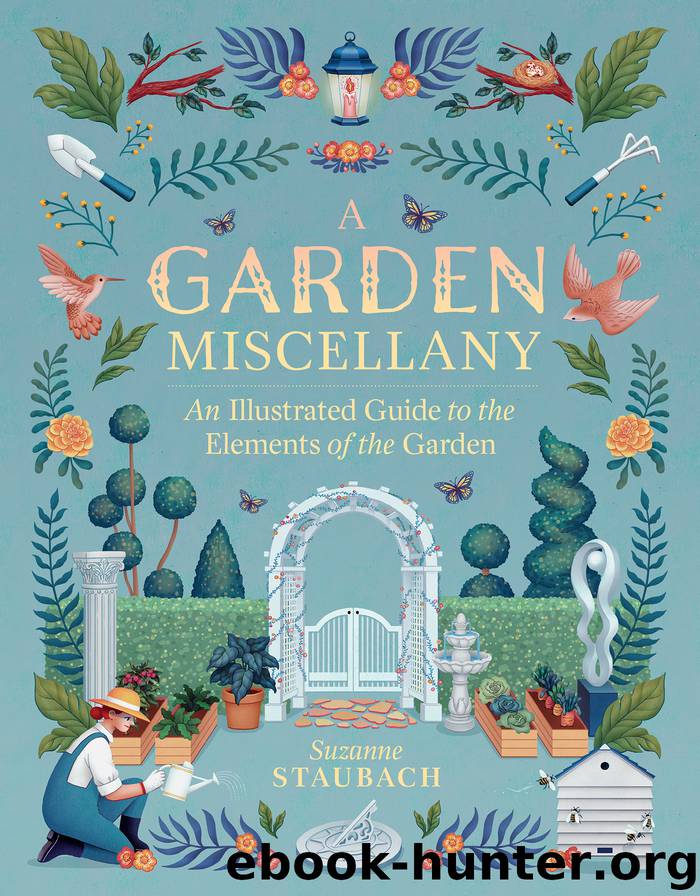A Garden Miscellany by Suzanne Staubach

Author:Suzanne Staubach
Language: eng
Format: epub
Publisher: Timber Press
Published: 2019-02-25T16:00:00+00:00
Ha-Ha
A ha-ha is a ditch that is deep enough and wide enough to be a barrier for livestock, yet does not interrupt the view as a fence or wall would. A ha-ha was the original invisible fence. Early ha-has had a fence or hedge inside at the base. Later, more elaborate examples had one side made of slanted turf, while the opposite side was vertical, usually held in place with a stone or brick retaining wall.
Charles Bridgeman, William Kent, Capability Brown, and other landscape garden designers installed numerous ha-has during the eighteenth century. With a ha-ha in place, the lord of the manor could look out from his windows and see a flock of sheep contentedly grazing in his parklands, without worrying that the sheep would come close to the house and leave droppings on the lawn or nibble the flowers. A ha-ha brought a sense of openness to the vistas while separating formal areas from the meadows, pastures, and woodlands, or even neighboring properties. A ha-ha eliminated the sense of enclosure that had been a key feature of earlier gardens.
Alexander Pope, writing in 1724 about the ha-has in the garden at Stowe House in Buckinghamshire, England, said, “What adds to the beauty of this garden is that it is not bounded by walls, but by a ha-ha, which leaves you the sight of a beautiful woody country, and makes you ignorant how far the high-planted walks extend.” The ha-has that so impressed Pope were installed by Bridgeman. Later, Kent took charge, joined by and then followed by Brown who stayed as head gardener until he set out on his own. All three leading landscape gardeners had a hand in the gardens of Stowe.
Horace Walpole, also a fan of ha-has, claimed that the word ha-ha comes from the exclamation of surprise a visitor might emit when suddenly coming upon one: “Ha-ha!” or more aptly, “Ah-ha!” His explanation is disputed by some authorities, however. He also referred to the ha-ha at his estate, Strawberry Hill, as a “sunk fence,” saying that it was “a simple enchantment.”
Henry Repton, one of the last landscape gardeners of the eighteenth century, employed sunk fences (or a ha!ha! as he also referred to the feature) in his designs, and promoted their use and benefits in his book, The Art of Landscape Gardening. He cautioned against half measures or compromises when making a ha-ha: old boundaries must go, and the ha-ha must be straight. The result, however, was “imaginary freedom” in land that was actually subdivided and bounded.
Contemporary gardeners have also discovered that a ha-ha can be a design element itself or inspire one. Charles Jenks has used the ha-ha concept in his landforms at his Garden of Cosmic Speculation in Scotland. Others make more traditional ha-has, a much easier task with today’s earth-moving equipment.
Though ha-has are still employed in gardens today, designers must take safety into consideration to prevent unsuspecting visitors from tumbling head first into the bottoms of sunken ditches! Some jurisdictions require that they be made visible, which of course defeats the purpose of this clever contrivance.
Download
This site does not store any files on its server. We only index and link to content provided by other sites. Please contact the content providers to delete copyright contents if any and email us, we'll remove relevant links or contents immediately.
Turbulence by E. J. Noyes(7039)
The Thirst by Nesbo Jo(5786)
Gerald's Game by Stephen King(3918)
Be in a Treehouse by Pete Nelson(3213)
Marijuana Grower's Handbook by Ed Rosenthal(3119)
The Sprouting Book by Ann Wigmore(3053)
The Red Files by Lee Winter(2914)
The Remains of the Day by Kazuo Ishiguro(2619)
Sharp Objects: A Novel by Gillian Flynn(2445)
Christian (The Protectors Book 1) by L. Ann Marie(2394)
Organic Mushroom Farming and Mycoremediation by Tradd Cotter(2307)
The Culinary Herbal by Susan Belsinger(2062)
Stone Building by Kevin Gardner(1995)
The Starter Garden Handbook by Alice Mary Alvrez(1925)
Lilac Girls by Martha Hall Kelly(1876)
The Unlikely Pilgrimage of Harold Fry by Rachel Joyce(1836)
The Lean Farm Guide to Growing Vegetables: More In-Depth Lean Techniques for Efficient Organic Production by Ben Hartman(1785)
Urban Farming by Thomas Fox(1749)
Backyard Woodland by Josh VanBrakle(1587)
